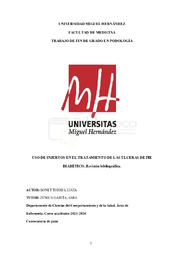Resumen :
Introducción: La Diabetes Mellitus puede causar complicaciones graves como el pie diabético, que a menudo lleva a úlceras difíciles de tratar y, en muchos casos, a amputaciones. Los injertos de piel y los reemplazos de tejidos han surgido como tratamientos prometedores para estas úlceras de pie diabético. El objetivo principal de esta investigación fue evaluar la eficacia del uso de injertos en el tratamiento de las úlceras de pie diabético y su impacto en la reducción de complicaciones asociadas.
Métodos: Se llevó a cabo una revisión bibliográfica utilizando las bases de datos Medline (PubMed), Scopus y Cochrane Library. Se incluyeron ensayos clínicos controlados aleatorizados, ensayos clínicos y estudios piloto realizados en humanos y publicados en los últimos 10 años. Estos estudios debían comparar el uso de injertos con el tratamiento estándar en úlceras de pie diabético. La calidad metodológica de los estudios seleccionados se evaluó utilizando la escala PEDro.
Resultados: Se incluyeron un total de 14 estudios en la revisión, todos ellos ensayos clínicos aleatorizados. Se analizaron las características de los pacientes, de las úlceras, las tasas de cicatrización, el tiempo promedio hasta el cierre de las úlceras de pie diabético, los efectos adversos y los costos asociados al uso de injertos en su tratamiento.
Conclusión: El uso de injertos es eficaz en el tratamiento de úlceras de pie diabético, aumentando la tasa de cicatrización y reduciendo el tiempo de curación. Su coste inicial puede ser mayor que el de los tratamientos estándar. Sin embargo, puede reducir los costos totales a largo plazo debido a la reducción de hospitalizaciones, tratamientos adicionales y complicaciones. Los efectos adversos son mínimos, con solo un estudio reportando un caso en el grupo de intervención.
Introduction: Diabetes Mellitus can lead to severe complications such as diabetic foot, often resulting in hard-to-treat ulcers and, in many cases, amputations. Skin grafts and tissue replacements have emerged as promising treatments for these diabetic foot ulcers. The primary objective of this research was to evaluate the efficacy of using grafts in the treatment of diabetic foot ulcers and their impact on reducing associated complications.
Methods: A literature review was conducted using the Medline (PubMed), Scopus, and Cochrane Library databases. Randomized controlled trials, clinical trials, and pilot studies conducted in humans and published in the last 10 years were included. These studies had to compare the use of grafts with standard treatment in diabetic foot ulcers. The methodological quality of the selected studies was assessed using the PEDro scale.
Results: A total of 14 studies were included in the review, all of which were randomized clinical trials. The analysis focused on the general characteristics of the interventions, patient characteristics, features of the ulcers, healing rates, the average time to diabetic foot ulcers closure, adverse events, and the costs associated with the use of grafts in diabetic foot ulcers treatment.
Conclusion: The use of grafts is effective in the treatment of diabetic foot ulcers, increasing the healing rate and reducing the healing time. Its initial cost may be higher than standard treatments. However, it can reduce overall long-term costs due to decreased hospitalizations, additional treatments, and complications. Adverse events are minimal, with only one study reporting a case in the intervention group.
|
 La licencia se describe como: Atribución-NonComercial-NoDerivada 4.0 Internacional.
La licencia se describe como: Atribución-NonComercial-NoDerivada 4.0 Internacional.
.png)
